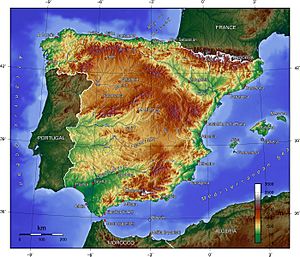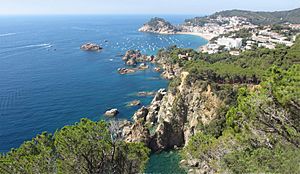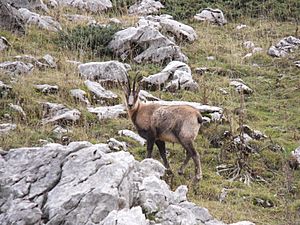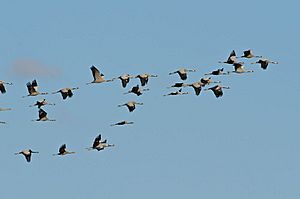Wildlife of Spain facts for kids
The wildlife of Spain includes all the amazing plants and animals that live there. Spain is a country in Europe with a long coastline on the Atlantic Ocean and another on the Mediterranean Sea. It also includes islands like the Canary Islands and the Balearic Islands. Plus, it has two small areas in North Africa called Ceuta and Melilla. Spain is home to many unique species, especially on its islands. You can find different types of homes for animals and plants, like mountains, forests, rivers, coasts, and grasslands.
Contents
Geography: Where is Spain?
Spain is located in southwestern Europe, on a piece of land called the Iberian Peninsula. It's to the east of Portugal and south of France and the Pyrenees mountains. Spain has a long coast along the Atlantic Ocean and another along the Mediterranean Sea. It also includes the Canary Islands in the Atlantic and the Balearic Islands in the Mediterranean. Most of mainland Spain is a high, flat area called a plateau, surrounded by mountains. The main low-lying areas are the Ebro Basin in the northeast and the Andalusian Plain in the southwest.
Climate: What's the Weather Like?
Most of Spain has a Mediterranean climate. This means it has warm or hot, dry summers and most of its rain falls in winter. Some parts, like the southeast and the Ebro basin, have a semi-arid climate. Here, summers are hot and winters are cool, but there isn't much rain all year round.
The northern part of Spain has an oceanic climate. This means the Atlantic Ocean influences temperatures, making them milder in both winter and summer. Rain is spread out throughout the year here. The Balearic Islands have a Mediterranean climate, while the Canary Islands are affected by the ocean and their closeness to Africa.
Biodiversity: A Rich Mix of Life
Spain has one of the highest numbers of different living things (biodiversity) in Europe. This is because it has four main natural areas: Atlantic, Alpine, Mediterranean, and Macaronesian. Spain is even considered one of the world's "biodiversity hotspots." To protect its amazing nature, about 27% of Spain is part of national parks, wildlife reserves, and other protected areas. This is thanks to a European Union plan called Natura 2000.
Flora: The Plants of Spain
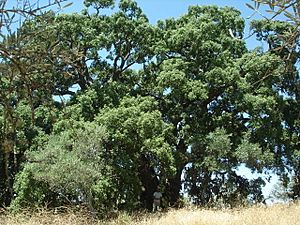
Spain, including its mainland and islands, has between eight and nine thousand types of vascular plants. This is more than any other country in Europe! About 20 to 25% of these plants are endemic, meaning they are found only in Spain. Sadly, a higher number of these unique plants are in danger than in any other European country. Mainland Spain has 822 endemic plant species, and the Balearic Islands have 103.
Many of the flat areas and valleys in the middle of Spain used to be covered in forests of holm oak and cork oak. In the south, you would also find wild olive and carob trees. Today, only small parts of these natural forests remain. Much of this land is now covered with thick bushes and scattered small trees, known as maquis.
On sandy soils, you'll mostly see Stone pine and maritime pine trees. In areas with limestone, Aleppo pine, Kermes oak, and juniper trees are common.
At higher altitudes, the Pyrenean oak grows up to about 1,500 meters (4,900 feet). Above that, Scots pine and juniper trees take over. Along rivers, only small parts of the natural forests of willow, poplar, alder, ash, and elm trees are left.
The northwestern coast of Spain has many forests with common oak, lime, chestnut, elm, ash, maple, and hazel trees. Where there are no trees, you'll find heather and gorse. Some parts of southeastern Spain have a type of dry, grassy land called steppe vegetation.
Fauna: The Animals of Spain
Spain, including its mainland and islands, is home to an estimated sixty to seventy thousand different animal species. About seven hundred of these are vertebrates (animals with backbones, not including marine fish), and the rest are invertebrates (animals without backbones). The most unique species (endemic) are found among freshwater fish, in mountainous areas, along the coasts, and among the animals of the Canary Islands. Sadly, about 30% of Spain's vertebrates are in danger.
Mammals
Land mammals native to Spain include the European hedgehog, two types of mole, the Pyrenean desman, and about a dozen types of shrew. There are also about thirty-five types of bat, plus the European rabbit, the European hare, and two other hare species.
Larger rodents include the Eurasian beaver, the red squirrel, the Alpine marmot, and the brown rat. There are also about twenty-eight types of mice, voles, and other small rodents. Among the hoofed animals, you can find the wild boar, the fallow deer, the red deer, the roe deer, the Iberian ibex, and the Pyrenean chamois.
Carnivores (meat-eaters) include the brown bear, the Iberian wolf, the Italian wolf, the red fox, the Iberian lynx, the Eurasian lynx, and the common genet. Other carnivores are the European badger, the Eurasian otter, the stoat, the least weasel, the European polecat, and the European pine marten. The coast is visited by six types of seal, and the waters around Spain are home to thirty types of whales, dolphins, and porpoises.
Birds
With its many different habitats, Spain has a huge number of bird species, with 644 recorded. Seven of these are endemic, meaning they live only in Spain. These unique birds are found on the offshore islands and include Bolle's pigeon, laurel pigeon, Canary Islands oystercatcher (which is now extinct), Canary Islands chiffchaff, Balearic warbler, Canary Islands stonechat, and Tenerife blue chaffinch.
Besides the many birds that live in Spain all year, many migratory birds visit in spring and autumn. They travel between their winter homes in Africa and their breeding grounds in northern Europe.
The high plateaus are home to birds like Dupont's lark, horned lark, European roller, and black wheatear. The remaining oak woodlands provide winter homes for thousands of common cranes and breeding areas for white storks and black storks. You can also see birds of prey like the black-winged kite, short-toed snake eagle, cinereous vulture, and griffon vulture here.
Reptiles
Spain's rivers and lakes are home to various unique freshwater fish, including the endemic Spanish minnowcarp and Luciobarbus microcephalus. Among reptiles, you can find the Caspian turtle and European pond turtle. Other reptiles include Hermann's tortoise, Greek tortoise, and pond slider, as well as four types of sea turtles.
The common chameleon is also found in Spain. There are about sixty types of lizard, worm lizard, gecko, and skink. Many of these are unique to the Canary Islands and Balearics, and some live in Spain's areas in North Africa. Sixteen types of snake are also found in Spain.
See also
 In Spanish: Fauna de España para niños
In Spanish: Fauna de España para niños


